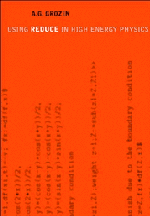1 - REDUCE language
Published online by Cambridge University Press: 20 October 2009
Summary
Welcome to REDUCE
First examples
In order to use REDUCE, first of all you need to start it. The method of doing so varies from systems to system. Typically, you type
reduce
at the operating system prompt, or click the corresponding icon. If this does not help, consult your local guru.
After REDUCE has loaded, it introduces itself: writes something like
REDUCE 3.6, 15-Jul-95, patched to 4 Jun 96…
After that, you can input REDUCE statements, terminating them by a semicolon.
When you become bored, say
bye;
to REDUCE.
In the rest of this Section, the transcript of a dialogue with REDUCE is presented, which demonstrates some of its capabilities. Statements input by the user are terminated by the character ;, while REDUCE answers are not. Some necessary comments are included.
The simplest thing you can ask REDUCE to do is to simplify an expression. To this end, you need to input this expression, terminating it with ;. REDUCE will answer by writing the simplified variant of this expression. As you can see from the examples, it expands brackets (collecting similar terms), and brings fractions to a common denominator.
It would be a pity if resulting expressions were simply lost. If you want to use an expression in further work, you need to assign it to some variable. After that you can use this variable to construct new expressions. It will be replaced by its value.
- Type
- Chapter
- Information
- Using REDUCE in High Energy Physics , pp. 1 - 80Publisher: Cambridge University PressPrint publication year: 1997



